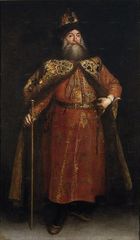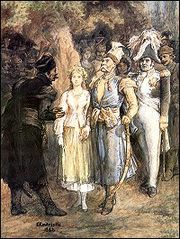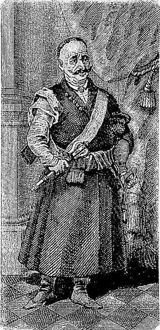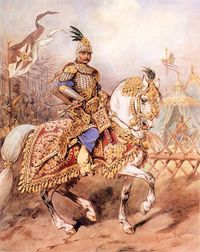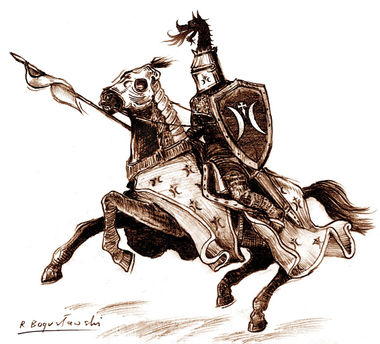Historia rodziny Danielewicz: Różnice pomiędzy wersjami
| Linia 4: | Linia 4: | ||
==Geneza pochodzenia== | ==Geneza pochodzenia== | ||
| − | [[Plik:Bojar.jpg| | + | [[Plik:Bojar.jpg|140px|right|]] |
Nie wiadomo kiedy Danielewicze zaczęły pieczętować się herbem Ostoja. Prawdopodobnie, rodzina została przyjęta do Rodu Ostoi na początku XV wieku, biorąc udział w społeczeństwie rodowym lub została przyjęta jeszcze wcześniej za czasu panowania Mościców, dowódcy sił zbrojnych o zawołaniu Ostoja. Ostoja była okrzykiem bojowym wszystkich, którzy służyłi Panom Mościcom. Naturalne i na zachodzie powszechne jest to, że rycerze służący u swojego Pana, używali znaku rodowego Mościców gdy ten przekształcił sie w herb najdalej pod koniec XIII wieku. | Nie wiadomo kiedy Danielewicze zaczęły pieczętować się herbem Ostoja. Prawdopodobnie, rodzina została przyjęta do Rodu Ostoi na początku XV wieku, biorąc udział w społeczeństwie rodowym lub została przyjęta jeszcze wcześniej za czasu panowania Mościców, dowódcy sił zbrojnych o zawołaniu Ostoja. Ostoja była okrzykiem bojowym wszystkich, którzy służyłi Panom Mościcom. Naturalne i na zachodzie powszechne jest to, że rycerze służący u swojego Pana, używali znaku rodowego Mościców gdy ten przekształcił sie w herb najdalej pod koniec XIII wieku. | ||
Wersja z 20:25, 17 sty 2013
Danielewicz vel Danilewicz - odwieczna szlachta, rodzina rycerska, jedna z najstarzych rodzin litewskich, która dołączyła do rodu Ostoi w połowie XV wieku. jako pierwszy użyć nazwy Danielewicz. Dawid, syn Daniela, był sędzią wileńskim około roku 1450.
Geneza pochodzenia
Nie wiadomo kiedy Danielewicze zaczęły pieczętować się herbem Ostoja. Prawdopodobnie, rodzina została przyjęta do Rodu Ostoi na początku XV wieku, biorąc udział w społeczeństwie rodowym lub została przyjęta jeszcze wcześniej za czasu panowania Mościców, dowódcy sił zbrojnych o zawołaniu Ostoja. Ostoja była okrzykiem bojowym wszystkich, którzy służyłi Panom Mościcom. Naturalne i na zachodzie powszechne jest to, że rycerze służący u swojego Pana, używali znaku rodowego Mościców gdy ten przekształcił sie w herb najdalej pod koniec XIII wieku.
Nie ma informacji na temat pochodzenia Daniela, niektórzy historycy uważają, że Daniel uczestniczył w Unii Horodelskiej w 1413 riku i że rodzina została wtedy przyjęta do rodu Rolitów z herbem Rola. Teoria ta nie jest jednak prawdopodobna ponieważ już syn Daniela używał herbu Ostoja w połowie XV wieku, a w tych czasach nie było innej rodziny Danielewicz niż herbu Ostoja. Chyba że synowie Daniela używali dwóch różnych herbów.
DNA projektu Ostoi potwierdza pochodzenie słowiańskie Ostoi Danielewiczów, grupa północno-wschodnia. Jest to liczna grupa do której należy wiele rodzin bojarskich. Około 1000-1300 lat temu, Danielewicz mieli wspólnego przodka z rodzinami Ejsmond h. Korab i Rudziecki h. Kościesza, Drya lub Ostoja. Herb tej szlachetnej rodziny nie jest na dzień dzisiejszy znany. Patrząc na pozycję wszystkich trzech rodzin, można przypuszczać że rodziny są pochodzenia rosyjskiego, idąc od Bojarów rosyjskich, co potwierdzają wyniki DNA. Po inwazji Mongołów w XIII wieku, wiele rodzin bojarskich z centralnej i południowej części Rusi (dziś Białoruś i Ukraina), dołączyło do braci litewskich z zachodu.
Historia
It is presumed that Daniel (Danil) participated in the Battle of Grunwald year 1410 and participated in following campagne. After the campagne he settled down nearby Vilnius where he was given land and property. According to the records, Daniel had two sons and one daughter. If them, Dawid was the first to use surname of Danilewicz which is very natural since it means son of Danil. Dawid was judge of Vilnius which also show that family was respected at that time.
According to Boniecki, Iwaszko Iwanowicz Danielewicz was serving at Royal Court during the time of Sigismund I the Old (pl: Zygmunt I Stary, lit:Žygimantas II Senasis) that also gave Iwaszko villages of Nieżylowy and Teszyłowy in Markow county year 1511. Iwaszko had a brother Fedor that also served at Royal Court 1523. Both contributed with 3 horses to war campagnes.
In 1530 Michał Danielewicz was in possession of 10 villages with different economic buildings on the property. His grandson, Jan Karzimierz Danielewicz was deputy to the Sejm from the Vilnius district.
Paweł Danielewicz voted with Vilnius voivodship for John II Casimir (pl: Jan II Kazimierz Waza) in election, he was Judge and Lord of regality (Starosta) of Intursk in year 1663. His son Adam Karol was Judge of Vilnius, died in 1686. His wife, Leonida Konstancya von Hertzdorf discussed with the Sapieha family about the dept that Sapieha family had to father of Adam Karol, Paweł Danielewicz.
Next generation of the Ostoja Danielewicz family is noted, Jan Hieronim , Paweł Jerzy, Mikołaj and Roman, of them Roman was first steward (podstoli) of Oszmiany and later Lord of regality of Intursk and the Chamberlain of Oszmiany. Mikołaj was Sword-bearer (miecznik) of Wilkomierz and later deputy of Lord of regality (podstarosta). All of them signed for Michał Korybut Wiśniowiecki in election of the King. Voting for Wiśniowiecki was more voting for his father, nobody then knew that the son of great Jarema Wiśniowiecki would be such a catastrophe but it can be assumed that the Magnates of the Commonwealth wished to have totally incompetent ruler that served their interests. In this time, families of Radziwiłł, Zamoyski, Pac and Sapieha ruled the Grand Duchy of Lithuania.
Roman, the Chamberlain of Oszmiany signed for Jan III Sobieski in his election as the King. He was married to Katarzyna Pac, daughter of Heronim Domink Pac, son of Piotr, the Voivode of Troki, their son Michał was adopted by Katarzyna Pac's oldest brother since he had no own son's and with that, the possessions of Piotr Pac and Tekla Wołłowicz past in most to his possessions to the the family of his daughter, additionally Roman Danielewicz bought the town of Korciany from the the Voivode in 1680. The couple had a doughter Teresa that married to Krzysztof Sulistrowski, Marshal of the Lithuanian Confederation 1716-1717, and sons Piotr, Kazimierz and Michał.
This line of Danielewicz will through next 100 years be one of the most prominent families in the county of Plotelsk.
Linia Romana Danielewicza
Piotr Danielewicz, son of Roman Danielewicz and Katarzyna Pac attended year 1691 to Academy in Vilnius, records tell about Piotr's wisdom and knowledge. In the testament of year 1710, Katarzyna Pac name Michał that was the Lord of regality of Plotelsk and appointed by the Sejm to commissar of the Hungarian boarder. Michał married to Eleonora Zenowicz, daughter of the Chamberlain of Połock. She also name her son Kazimierz.
Eleonora and Michał had three son's, from which there are three lines:
- Franciszek - Lord of regality of Plotelsk, married to Anna Nowkuńska and from that marriage they had son Franciszek Tadeusz, Colonel of Polish army. Colonel Franciszek married Aniela Mirska and with her he had two son's Michał and Adam. Of them Michał was Standard-bearer of Petyhorsk regiment and Judge of Smolensk. Adam, younger son of Franciszek Danielewicz and Aniela Mirska married to Joanna Malinowska and with her he had son's Michał Wincenty, born in Vilnius year 1792 and Tomasz. Michał Wincenty married to Katarzyna Szymkiewicz and with her had a son, Juliusz Bronisław, born in Nowianki 19th of september 1849. All members of this line was registered year 1835 in the books of nobility in Vilnius province.
- Konstanty - oldest son of Eleonora and Michał received family property and Manor house in Sulżyn year 1704, Owrucz county in Volhynia. From Konstanty origin the Volhyn line of Ostoja Danielewicz. Konstanty had a son Jan, born in 1720 in Przewrocie. Jan sold part of the property of Sulżyn to Feliński in 1758. He married to Zofia Wietwicka and with her he had a son Aleksander, born in Słobódka 1765. Aleksander married to Teresa Krasnopolska and with her he had four son's: Stefan Arseniusz, born in Zalesie 1818, Józef Gorgoniusz, born 1813 (rec. Jarmolińce), Wincenty, born 1807 (rec. Hrymiacze) and Robert, born 1810 (rec. Jarmolińce). Aleksander had also a daughter Justyna Paulina, born in Zalesie 1820. Józef Gorgoniusz married to Wiera Alexandrowna and with her he had a son, Eufemiusz, born in Lipowiec 1845. This line of Danielewicz was registered in nobility books of Russian Empire year 1850. Genealogy tree of the Volhyn line of Ostoja Danielewicz.
- Michał Danielewicz - son of Michał Danielewicz and Eleonora Zenowicz, landowner in Minsk voivodeship gave property of Sakowicze to his son Franciszek and he past this property to his son Kazimierz in 1758. Then property of Wielkie Uzły in Oszmiana county was given to younger son of Franciszek, Michał Danielewicz.
Katarzyna Szwejkowska married to Jan Danielewicz, had son's Michał Jakób and Franciszek, with second wife Tekla Mackiewicz he had son Tomasz, born 1794. Wincenty Danielewicz, born 1830 and Jan, son of Tomasz and Franciszka Karnicka, born in Widze 1819 was registered in the books of nobility of Russian Empire in year 1856.
Inne linie Ostoi Danielewiczów
Samuel Danielewicz - Rittmeister of Braclaw gave property of Wodopol (Tułowo) to his son Jan. Jan with his wife Lucyna Białonowicz gave property to their son Onufry, the captain of Royal forces. From this line, Dominik Danielewicz married to Katarzyna Zborowska and had two son's - Wincent and Antoni. Of them, Wincent married Konstancya Podskoczym and had five sons with her. His brother Antoni married Anna Ostrowska and had four son's with her. of them, Wincenty married to Karolina Horodecka and had a son, Sylwester Mikołaj, born in Kozince 1840. Another son of Antoni, Michał married to Teresa Marcinkiewicz and had a son, Wiktor, born in Putreniszki 1847. Stefan married Antonella Rogowska and Józef married Donata Niemiro of Jastrzębiec Coa and had two sons, Antoni born in 1855 and Julian born 1860.
Franciszek, son of Dominik, married Elżbieta Budzinowska, they had two sons, Floryan Dominik and Jan.
Michał, grandsonson of Jan and son of Onufry Danielewicz married to Urszula Grzybowska, they had five son's. Of them Józef Antoni married to Bogumiła Kozłowska and had three sons. Antoni married to Zuzanna Truskowska and they had two son's togehter, Adam Michał born 1843 and Piotr, born 1854 in Janopol.
Marcin Danielewicz, son of Józef, Treasurer of Kowno 1746, owner of property Sokołeńszczyzna in Oszmiany county. In this line, Kazimierz married Katarzyna Kontowt 1787. Kazimierz, son of Kazimierz married Anna Rożyńska and had five sons. Of them Andrzej was owner of property of Przystowian v. Miciun and married Józefa Borodzicz. Marcin, son of Kazimierz married Anastazya Skaczkowska and with her he had three son's and one daughter. His son Ignacy was owner of property Noborowszczyzna until 1832. Ignacy married to Wanda Kozubska and had four son's with her. This line is registered in the nobility books of the Russian Empire in year 1840, 1853 and 1854.
Jan Danielewicz, son of Marcin Danielewicz - owner of Gudziany in Trakai voivodeship before 1719. His son Tadeusz was Rittmeister of the Trakai voivodeship, married Petronela Sopoćko, owners of property Lewszany and Piełaniszki. Szymon Danielewicz, son of Tadeusz Danielewicz was Rittmeister of Trakai voivodeship in 1775. Antoni, son of Szymon married to Katarzyna Kondratowicz and had with her five son's and three daughters. In this line Józef, son of Szymon was captain of Royal forces and another son of Szymon, Cyprian Danielewicz married first to Rozalia Wersocka and then to second wife, Rozalia Korsak. Another son of Szymon and Anna Randomańska, Onufry Danielewicz married to Teresa Januszkiewicz an had a son, Zygmunt that married to Teresa Grużewska, they had two sons and one daughter, of them Kazimierz Antoni was born in Słoboda 1860 and Benedykt Michał was born 1864 in St. Petersburg, Russia.
Wincenty, son of Tadeusz had two son's; Jan Franciszek and Jakób, owners of property Krupieliszki (Walkinie) until year 1834. Józef, son of Tadeusz was owner of the property Jodzienie-Szłowiany 1777.
This line of Ostoja Danielewicz wa registered in the books of nobility of Vilnius province in 1859, 1862, 1881 and 1882.
A line of Danielewicz moved to Prussia during the partition time. Of them, Carl Friedrich v. Danielewicz was major in Prussian army in 1806 and another Danielewicz was second lieutnant.
Bohdanów
In 1653 the property of Bohdanów named after Prince Bohdan Sapieha in Belarus were passed to Barbara, daughter of Prince Karzimierz Sapieha. Barbara's daughter Tekla Wollowicz then married Piotr Michal Pac and the property passed to the Pac family. Since Piotr Michal Pac had no children of his own, he adopted Michal Danielewicz,(Starosta of Plotelsk, Inspector of the Hungarian boarder) into the Pac family as he was the son of his sister Katarzyna Pac, daughter of Piotr Pac, Voivode of Trakai. As result of that, the Bohdanow property among others was passed from the Pac family to Danielewicz.
W czasie zaborów
During the Partitions of Poland or Partitions of the Polish–Lithuanian Commonwealth 1772-1918, Danielewicz's participated in many upraising actions witch cause Russian side to confiscate most of the family properties. As the family did not support foreging forces in the Commonwealth and was in opposition, no offices was given to the family anymore. In the end o 18th century part of the family moved to Preussen where they joined Prussian army as officers in hope to fight Russian side that was holding control of the east part of the Commonwealth. After the Napoleonic wars, Marcin Danielewicz received the Order of the White Eagle for his efforts in the fight for the independence of the Commonwealth. Jan Danielewicz died on the fields of Olszynka Grochowska in November Uprising, Piotr Danielewicz participated in 1863 Upraising in Vilnius (the January Uprising) and after the uprising failed, he was sent to Siberia from witch he never come back.
As the consequence of the January Uprising, 80.000 people was deported (according to professor Norman Davies, Gods playground, History of Poland, Oxford university Press 1981 witch is the largest single deportation in Russian history. Whole villages and towns were burned down; all activities were suspended and the nobility, was ruined by confiscation and exorbitant taxes. In 1905, 41 years after Russian crushing of the uprising, the next generation of Poles rose once again in a new one. Among them, Karol Ostoja Danielewicz was deported for teaching Youth the polish language, preserving polish culture and traditions which was forbidden by the Russian authorities.
At the end of 19th century, the family was divided into three lines; the Prussian, Lithuanian-Belarus and Volhynia line. In total, 26 males was found registered nobility of the Ostoja Clan. Part of the Volhynia line of Ostoja-Danielewicz was excluded from Russian records after taking part in upraising.
Znani przedstawiciele rodziny Ostoi Danielewiczów
- Dawid Danielewicz - Judge of Vilnius
- Jan Kazimierz Danilewicz - Deputy to the Sejm
- Paweł Danielewicz - Judge of Vilnius 1648, Lord of regality of Intursk, Marshal of the Lithuanian Court of Justice
- Adam Karol Danielewicz - Judge of Vilnius
- Roman Danielwicz - Lord of regality of Intursk, deputy to the Sejm, Chamberlain of Oszmiany
- Michał Danielewicz - Lord of regality of Plotelsk, commissar of the Hungarian boarder
- Franciszek Danielewicz - Lord of regality of Plotelsk
- Franciszek Danielewicz - son of Franciszek, Lord of regality of Plotelsk. He was Colonel of Royal Army
- Michał Danielewicz - son of colonel Franciszek, Standard-bearer of Petyhorsk regiment and Judge of Smolensk
- Samuel Danielewicz - Rittmeister of Bracławy
- Onufry Danielewicz - captain of Royal Army
- Tadeusz Danielewicz - Rittmeister of Trakai
- Szymon Danielewicz - Rittmeister of Trakai 1775
- Józef Danielewicz - son of Rittmeister Szymon was captain of Royal Army
- Marcin Danielewicz - received Order of the White Eagle, Major in the army of Napoleon.
- Władysław Danielewicz - Lwow Eaglets (Orleta Lwowskie) 1918
Majątki ziemskie Ostoi Danielewiczów
Sources
- Adam Boniecki, Herbarz Polski, Warszawa 1901, V.4, page 80-84
- Seweryn Uruski, Rodzina, Herbarz Szlachty Polskiej, Warszawa 1904, V.3, page 64
- Roman Aftanazy Dzieje dawnych rezydencji na dawnych kresach Rzaczpospolitej, Wojewodztwo Wilenskie, t.4, s.37, 120
- C. Jankowski, Powiat Oszmanski, t.1, s. 223 i n.

